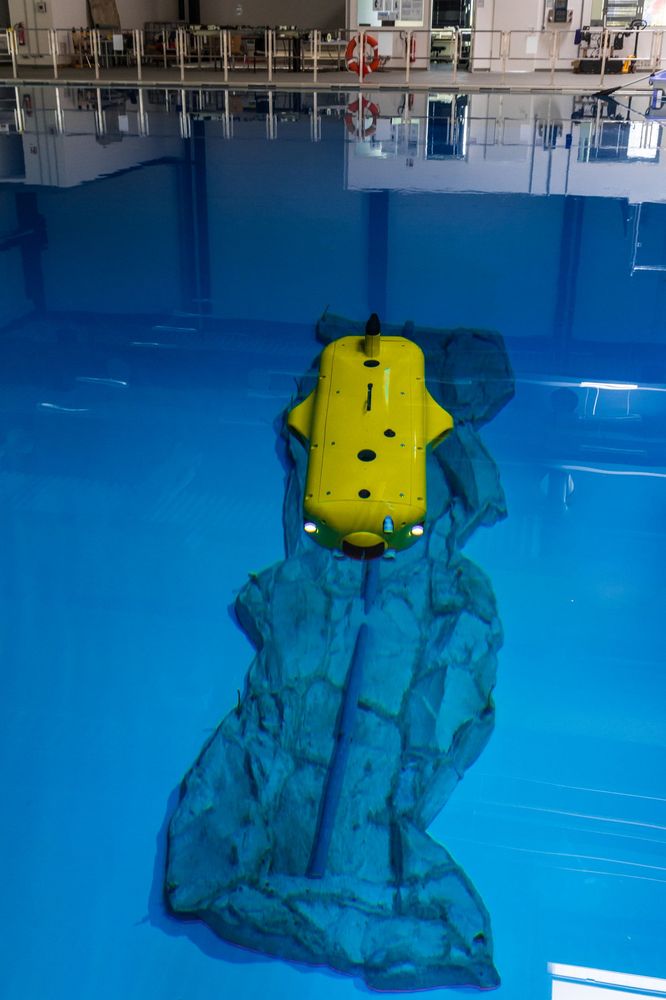Flatfish
Subsea-resident AUV
Contact person:
Technical Details
| Size: | 205 cm x 96 cm x 50 cm |
| Weight: | 275 kg in-air |
| Power supply: |
5.8 kWh Li-Ion battery, extension option to 11 kWh
|
| Speed: | 3 knots |
| Actuation/ Engine: |
6x Enitech ring thruster, 60 N each
|
| Sensors: |
BlueView MB1350-45
Tritech Gemini 720i
2x Tritech Micron Sonar
1x Oculus M1200d Sonar
4x Camera: Basler ace-2040-25gc, 2040x2040 pixels each
2x Laser line projector, 532 nm
Rowe Dual Frequency DVL, 300kHz/1200kHz
Digiquartz 6000 Series Pressure Sensor
KVH 1750 IMU
Evologics 48/78 USBL
|
| Communication: |
Evologics 48/78 acoustic modem
50m Gigabit Copper Tether
500m Gigabit Fiber Tether
54 Mbps WiFi
|
Organisational Details |
|
| Partner: | FIEB/SENAI, BG Brasil |
| Sponsor: |
EMBRAPII
anp |
| Application Field: | Underwater Robotics |
| Related Projects: |
JIRo
Joint Inspection Robot
(01.2018- 03.2020)
EurEx
Europa-Explorer
(12.2012- 04.2016)
CUSLAM
Localization and mapping in confined underwater environments
(09.2009- 07.2012)
|
| Related Robots: |
DAGON
Exploration AUV for long-distance-missions
|
System description
FlatFish is an autonomous underwater vehicle (AUV) for repeated inspections of oil & gas subsea structures whilst being submerged for extended periods of time.
To achieve this, a variety of acoustic and optical sensors are employed and a subsea docking station has been designed
Two identical autonomous underwater vehicles (AUVs) were built, enabling simultaneous software development in both Brazil (Brazilian Institute of Robotics at SENAI-CIMATEC in Salvador) and Germany.
Mission scenario:
The vehicle is docked near an offshore facility and connected to a power supply and data uplink. The operator (either on the facility or at a remote location) commands the vehicle to perform an inspection task. Where the inspection target is remote from the facility the AUV undocks and follows a pipeline or flow line to a target area whilst collecting acoustic and visual data of the pipeline or flow line. Upon reaching the target area, acoustic and visual data from the inspection object is gathered. The vehicle then backtracks using acoustic and visual homing algorithms to return and connect to the docking station. The recorded data is then uploaded to be processed by automated systems and/or the human operator whilst the vehicle’s battery is being recharged. At the same time, the operator has the option of defining a follow-up mission.
DFKI’s contributions to the FlatFish project include the mechanical and electrical design of the vehicle as well as manufacturing and integration of the AUVs. Also, the basic software modules will be implemented at DFKI to allow for sensor data processing, vehicle control and navigation solutions such as waypoint following.
Higher-level algorithms will be developed as a joint effort between DFKI in Bremen and BIR in Salvador, Bahia.
To achieve this, a variety of acoustic and optical sensors are employed and a subsea docking station has been designed
Two identical autonomous underwater vehicles (AUVs) were built, enabling simultaneous software development in both Brazil (Brazilian Institute of Robotics at SENAI-CIMATEC in Salvador) and Germany.
Mission scenario:
The vehicle is docked near an offshore facility and connected to a power supply and data uplink. The operator (either on the facility or at a remote location) commands the vehicle to perform an inspection task. Where the inspection target is remote from the facility the AUV undocks and follows a pipeline or flow line to a target area whilst collecting acoustic and visual data of the pipeline or flow line. Upon reaching the target area, acoustic and visual data from the inspection object is gathered. The vehicle then backtracks using acoustic and visual homing algorithms to return and connect to the docking station. The recorded data is then uploaded to be processed by automated systems and/or the human operator whilst the vehicle’s battery is being recharged. At the same time, the operator has the option of defining a follow-up mission.
DFKI’s contributions to the FlatFish project include the mechanical and electrical design of the vehicle as well as manufacturing and integration of the AUVs. Also, the basic software modules will be implemented at DFKI to allow for sensor data processing, vehicle control and navigation solutions such as waypoint following.
Higher-level algorithms will be developed as a joint effort between DFKI in Bremen and BIR in Salvador, Bahia.
Videos
FlatFish: Autonomous SSIV Inspection & Docking
Fully autonomous FlatFish mission: The AUV undocks, inspects its target (SSIV, subsea isolation valve) and returns to its docking station.

